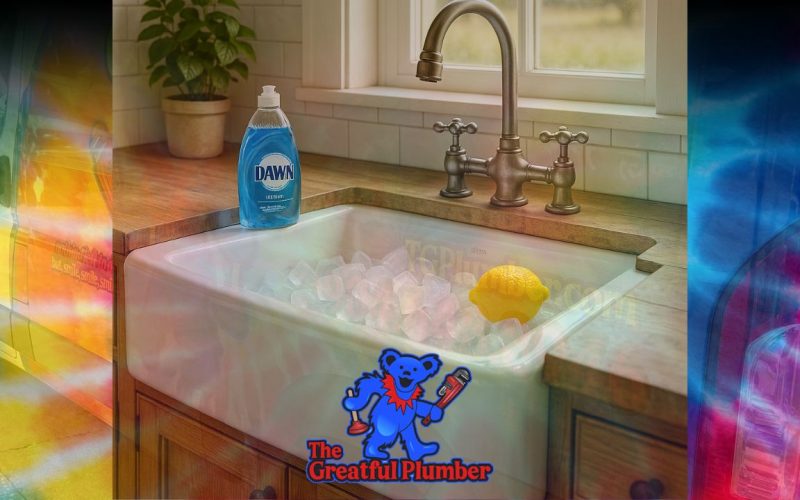Your kitchen drain doesn’t ask for much. It handles everything you throw at it, literally, from Monday morning coffee grounds to Sunday dinner cleanup. But ignore it long enough, and you’ll find yourself staring into a sink full of standing water, wondering how you got here.
The good news? Most kitchen drain problems are completely preventable with simple habits and a little monthly maintenance. At The Greatful Plumber, we see the same avoidable clogs every week, and we’re here to help you skip the emergency service call.
Why Kitchen Drains Fail (And It’s Probably Your Fault)
Let’s be honest about what’s really going down your drain. You know you shouldn’t pour grease down there, but what about the greasy pan water? The butter that melted while washing dishes? The olive oil residue from that pasta bowl?
Here’s what happens: Grease doesn’t just wash away. When hot grease hits your pipes, it sticks to the walls and hardens as it cools. Do this daily for months, and you’re building up layers of gunk that eventually catch everything else, hair, food particles, soap scum, creating a clog that won’t budge with a plunger.
Add in a garbage disposal that people treat like a trash compactor, and you’ve got a recipe for a Saturday night backup right when you have guests over.
The Dawn Dish Soap Ice Cube Method (Actually Works)
This sounds too simple to be effective, but it’s one of the best preventive maintenance tricks we know. Here’s how it works:
What You Need:
- Dawn dish soap (the blue original formula works best)
- Ice cube tray
- Hot water
- 5 minutes once a month
The Process:
Fill an ice cube tray about halfway with Dawn dish soap. Top it off with water and freeze overnight. Once a month, turn on your garbage disposal and drop 3-4 of these ice cubes down the drain. Run cold water and let the disposal chop up the ice.
Why This Works:
The ice acts as an abrasive cleaner, scrubbing the disposal blades and grinding chamber while the Dawn breaks down grease and food residue. As everything melts, the soapy water flushes through your pipes, cutting through grease buildup. The cold water keeps the grease solid long enough to get chopped up and flushed away instead of coating your pipes.
Do this monthly, and you’ll notice your disposal stays cleaner, smells better, and your drain flows faster.
What Should Never Go Down Your Kitchen Drain
Even with a garbage disposal, some things are asking for trouble. Here’s the actual list of what we pull out of clogged drains:
The Obvious Offenders
- Grease, oil, and fat from any source (yes, even small amounts add up)
- Coffee grounds (they don’t break down and create sludge)
- Eggshells (the membrane sticks to pipes like glue)
- Potato peels (turn into a starchy paste that clogs)
- Pasta and rice (continue to expand with water)
The Sneaky Problems
- Flour (creates paste when mixed with water)
- Produce stickers (those tiny fruit labels never break down)
- “Flushable” wipes (spoiler: they’re not flushable or drain-friendly)
- Medication (environmental issue and potential clog)
- Fibrous vegetables (celery, asparagus ends, corn husks wrap around disposal blades)
Pro Tip: If you wouldn’t compost it or it feels sticky, slimy, or starchy, it belongs in the trash, not your drain.
The Right Way to Handle Grease
You can’t avoid grease entirely, but you can manage it properly:
After Cooking:
- Let grease cool in the pan until it starts to solidify
- Scrape it into a container (old coffee cans work great)
- Dispose of the container in your trash when full
- Wipe the pan with paper towels before washing
- Wash greasy dishes with very hot water and plenty of dish soap
For Small Amounts: If you must rinse minimal grease (we’re talking drops, not tablespoons), run very hot water for at least 30 seconds before and after to help push it through your pipes. Follow with the Dawn ice cube treatment that same week.
Garbage Disposal Do’s and Don’ts
Your garbage disposal isn’t a trash compactor. It’s designed to handle small food scraps that accidentally go down the drain, not your dinner leftovers.
Do:
- Run cold water before, during, and for 15 seconds after using the disposal
- Feed food waste in gradually, not all at once
- Grind citrus peels occasionally for natural deodorizing
- Run it regularly even when you don’t need it (keeps parts moving)
- Use the Dawn ice cube method monthly
Don’t:
- Put your hand in there (use tongs or pliers to retrieve items)
- Grind bones, shells, or hard pits (they’ll dull the blades)
- Turn it off immediately after grinding (let water run 15 more seconds)
- Ignore strange sounds (grinding metal means something’s wrong)
- Use chemical drain cleaners (they damage disposal components)
DIY Drain Cleaning Methods That Work
Before calling for help, try these safe, effective methods:
The Baking Soda and Vinegar Method
Pour 1/2 cup baking soda down the drain, followed by 1 cup white vinegar. Cover the drain with a plug or wet cloth. Let it fizz for 15-30 minutes, then flush with hot water. This breaks down mild buildup and deodorizes.
Reality Check: This works for minor slowdowns and maintenance, not serious clogs. If water isn’t draining at all, you need stronger measures.
The Boiling Water Flush
Once a week, boil a full kettle of water and pour it slowly down the drain in two or three stages, letting it work for a few seconds between pours. This melts grease and flushes debris.
Caution: Only use this method if you have metal pipes. PVC pipes can warp with boiling water, use very hot tap water instead.
The Plunger Method
Yes, you can plunge a kitchen sink. Fill the sink with a few inches of water, place a wet cloth over the overflow opening (if there is one), and plunge vigorously. This creates pressure that can dislodge clogs.
For double sinks, plug one side completely before plunging the other.
The P-Trap: Your First Line of Defense
That U-shaped pipe under your sink isn’t just for looks. It’s called a P-trap, and it serves two purposes: it traps debris before it gets to your main drain line, and it holds water that prevents sewer gases from backing up into your home.
When to Clean Your P-Trap:
- Water drains slowly even after plunging
- You smell sewer odors near the sink
- You’ve dropped something valuable down the drain
- As annual preventive maintenance
How to Clean It:
- Place a bucket under the P-trap
- Unscrew the slip nuts by hand or with pliers (turn counterclockwise)
- Remove the trap and dump contents into bucket
- Clean inside with a bottle brush and soapy water
- Check the washers for cracks and replace if needed
- Reassemble and hand-tighten (don’t over-tighten)
- Run water and check for leaks
This 10-minute job prevents countless clogs and gives you a chance to inspect your pipes for corrosion or damage.
Signs Your Kitchen Drain Needs Professional Help
Some problems are beyond DIY fixes. Call a plumber when you notice:
- Multiple drains backing up simultaneously (indicates main line problem)
- Recurring clogs in the same spot (pipe damage or major buildup)
- Water backing up into other fixtures when you run the disposal
- Foul odors that won’t go away (could be cracked pipes or vent issues)
- Visible leaks under the sink or at connections
- Disposal makes grinding metal sounds (something’s jammed or blades are damaged)
Emergency Warning: If you have sewage backing up through your kitchen drain, shut off the water supply and call immediately. This indicates a serious main line blockage.
Creating Your Kitchen Drain Maintenance Routine
Consistency prevents emergencies. Here’s a simple schedule:
Daily:
- Scrape plates into trash before rinsing
- Run cold water for 15 seconds after using disposal
- Wipe greasy pans before washing
Weekly:
- Pour boiling (or very hot) water down drains
- Run disposal with citrus peels for freshness
- Check under sink for leaks or moisture
Monthly:
- Use the Dawn ice cube method
- Do the baking soda and vinegar treatment
- Inspect visible pipes for corrosion
Annually:
- Clean P-trap thoroughly
- Have a professional inspection if you have an older home
- Replace sink strainers if worn
The Dishwasher Connection Factor
Your dishwasher drains into your kitchen sink line, which means dishwasher problems can affect your sink drainage and vice versa.
Common Issues:
- Dishwasher backing up into sink (drain hose needs proper loop)
- Sink backing up when dishwasher drains (partial clog in shared line)
- Both draining slowly (main line issue)
If you notice these problems, check the dishwasher drain hose under your sink. It should loop up high before connecting to the drain or disposal to prevent backflow.
Hard Water Considerations
If you have hard water (high mineral content), you face additional challenges. Minerals build up inside pipes over time, narrowing the opening and creating rough surfaces that catch debris.
Signs of Hard Water Buildup:
- White crusty deposits around faucet aerators
- Spots on dishes even after washing
- Reduced water pressure over time
- Drains that get slower despite regular cleaning
Solutions:
- Install a water softener (whole house solution)
- Use vinegar treatments monthly to dissolve minerals
- Clean faucet aerators quarterly
- Consider pipe replacement if buildup is severe
What Not to Do (Lessons from Service Calls)
We’ve seen some creative attempts at drain cleaning. Here’s what NOT to do:
Never Use Chemical Drain Cleaners: Products like Drano create heat that can crack old pipes and damage garbage disposals. They rarely work completely and often make professional repairs more expensive.
Don’t Use a Wire Hanger: Seems like a good idea, but you’ll scratch pipes and potentially create new places for clogs to form.
Avoid Home Remedies Involving Bleach: Mixing bleach with other cleaners creates toxic fumes. It also doesn’t effectively clean drains.
Don’t Ignore Small Problems: That slight slow drain will become a complete backup, usually when you have a house full of guests.
When DIY Becomes a Problem
There’s a fine line between maintenance and making things worse. Stop and call a professional if:
- You’ve plunged for 10 minutes with no improvement
- Water starts backing up faster than before
- You hear gurgling from other drains when one is running
- DIY methods worked before but now nothing helps
- You’ve used chemical cleaners (tell the plumber, it affects how they work)
The Real Cost of Prevention vs. Emergency
Let’s talk money. A bottle of Dawn costs $3. A bag of ice cube trays costs $5. Your monthly maintenance investment is under $10.
An emergency drain cleaning service? $150-$400 depending on severity and timing. Main line repair? $500-$2,000. Full pipe replacement? Even more.
The math is pretty simple: 15 minutes of monthly maintenance saves hundreds in emergency repairs.
Final Thoughts: Respect Your Drains
Your kitchen drain works hard every single day. Treat it with a little respect, and it’ll rarely give you trouble. Skip the grease, use your disposal wisely, do the Dawn ice cube trick monthly, and pay attention to warning signs.
Most drain problems develop slowly over months. That means you have plenty of time to prevent them with simple habits. The homeowners who never have drain emergencies aren’t lucky, they’re just consistent with basic maintenance.
Ready to keep your kitchen drains flowing? Start with the Dawn ice cube method this weekend and build from there. Your future self (and your wallet) will thank you.
Need help with a stubborn kitchen drain? Call The Greatful Plumber at (904) 643-3946 or book online. We’re here when prevention isn’t enough!










